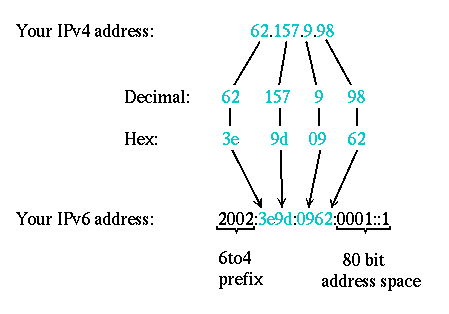You must have a static IP address for this to work.
This is some necessary information:
Static IPv4 address: 62.157.9.98
Static IPv6 address: 2002:3e9d:0962:1::1
Usable /48: 2002:3e9d:0962::/48
Note: A 6to4 calculator is available at grox.net - select IPv4 to 6to4 address
Setup the 6to4 interface
/interface 6to4 add mtu=1280 name=ipng-tunnel local-address=62.157.9.98 remote-address=192.88.99.1 disabled=no
Add your client IPv6 address to the new interface
/ipv6 address add address=2002:3e9d:0962:1::1/3 interface=ipng-tunnel
Add a default route to the global IPv6 Internet through the tunnel interface using the anycast IPv4 address:
ipv6 route add dst-address=2000::/3 gateway=::192.88.99.1,ipng-tunnel
Syntax for RouterOS v4.x, or RouterOS 3.x with routing-test:
ipv6 route add dst-address=2000::/3 gateway=::192.88.99.1%ipng-tunnel
You can now add your IPv6 addresses as required for your internal network.
Example:
/ipv6 address add address=2002:3e9d:0962:2::1/64 interface=ether1 advertise=yes disabled=no
Sumber : http://wiki.mikrotik.com/wiki/Setting_up_an_IPv6_tunnel_via_6to4

